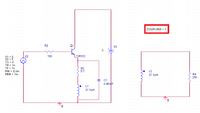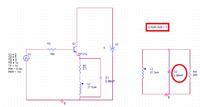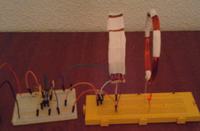CataM
Advanced Member level 4

- Joined
- Dec 23, 2015
- Messages
- 1,275
- Helped
- 314
- Reputation
- 628
- Reaction score
- 312
- Trophy points
- 83
- Location
- Madrid, Spain
- Activity points
- 8,409
I am trying to build a circuit that transfers electricity from a coil to an other (to the secondary due to Faraday's Law).
The circuit I built is the shown in the figure and I have 3 questions:
1) Is this going to work? I mean, how far I am going to be able to separate the second coil from the primary coil? The input voltage is provided by Arduino UNO...
2) To hit the resonance, it is correctly placed the 2 capacitances "C1" and "C2" shown in the picture above?
3) To determine the 2 capacitances, it is correct the following formula to use?
\[C=\frac{1}{4{\pi}^{2}{f}^{2}L}\]
L=inductance of the solenoid, f=1 kHz (provided by arduino)
The circuit I built is the shown in the figure and I have 3 questions:
1) Is this going to work? I mean, how far I am going to be able to separate the second coil from the primary coil? The input voltage is provided by Arduino UNO...
2) To hit the resonance, it is correctly placed the 2 capacitances "C1" and "C2" shown in the picture above?
3) To determine the 2 capacitances, it is correct the following formula to use?
\[C=\frac{1}{4{\pi}^{2}{f}^{2}L}\]
L=inductance of the solenoid, f=1 kHz (provided by arduino)
Attachments
Last edited:













